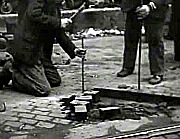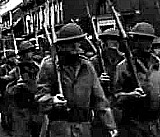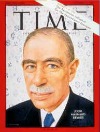Great Depression Facts
& Figures... 1929-1939.
1929 Great Depression Facts... have we made the same mistakes all over again?
The Stock Market... 1929 Depression Facts:

Chart courtesy Online Stock Trading Guide
- October 24th 1929 "Black Thursday"... stocks down 11% at opening bell.
- October 28th 1929 "Black Monday"... stocks down 13%.
- October 29th 1929 "Black Tuesday"... stocks down 12%.
- September 1931 "Black September"... Dow loses 53%, the bulk in a single month.
- July 1932... Dow closes at 41.22 ... down 89 % from the 381.17 peak of September 3rd 1929.
-
 Dow makes a come-back from a low of 41.22 in 1932 to reach 194.4 in 1937... up 372%.
Dow makes a come-back from a low of 41.22 in 1932 to reach 194.4 in 1937... up 372%. - Then another of many crashes along the way sees the Dow plunge 49% between
March 1937 - March 1938.
- Dow down 40% from September 1939 - April 1942.
- November 1954... investors finally see stocks rise back to 381.17 ... after 25 years!
- The average P/E ratio of S&P Composite stocks was 32.6 in September 1929.
Gross Domestic Product... 1929 Depression Facts:
-
 In the "Roaring Twenties" U.S. total debt reaches a record high of 190%
of GDP.
In the "Roaring Twenties" U.S. total debt reaches a record high of 190%
of GDP. - U.S. GDP down 33% between 1929-1933... falling 8.6% in 1930, 6.4% in 1931, and 13% in 1932
alone. GDP keeps falling and is soon down 50%.
- U.S. economic output plummets from $103 to $55 billion.
- By 1932 U.S. manufacturing output has slumped to 54% of its 1929 level.
 Grinding poverty forces the public to resort to digging up paving bricks for fuel.
Grinding poverty forces the public to resort to digging up paving bricks for fuel.- German industrial production falls by more than 30% after U.S. banks recall loans causing the German
banking system to collapse.
Money Supply & Interest Rates... 1929 Depression Facts:
- Federal Reserve cuts interest rates 7 times in 1930, from 6% down to 3.5%.

- 1931... Rates cut to 2.6%.
- 1933... Rates cut to 1.7% and held low until after World War II ends.
- The U.S. Federal Reserve allows the money supply to shrink by 30%.
Unemployment & Wages... 1929 Depression Facts:
- U.S. unemployment reaches 16.3% in 1931, 24.9% in 1932, and 25.1%
in 1933 (but soars to 35% in the industrial sector)... that's 12 to 15 million workers out of work.
-
 Unemployment is still 15% when World War II begins in 1939.
Unemployment is still 15% when World War II begins in 1939. - Incomes fall up to 42% for those still working.
- Farm incomes fall some 50%.
- 30,000 kilometers of trees are planted to reverse the 1935-1938 "Dust Bowl" effect caused by poor farm
practices.
-
 The Agricultural Adjustment Act is passed to provide relief to 6 million farmers and raise crop prices by
encouraging farmers to plow over-abundant crops into the ground and pour milk into the ground.
The Agricultural Adjustment Act is passed to provide relief to 6 million farmers and raise crop prices by
encouraging farmers to plow over-abundant crops into the ground and pour milk into the ground. - Around 2 million unemployed men aged 18-25 are put to work in the newly formed Civilian Conservation Corps.
and paid $30 per month for planting trees, cleaning up pollution, etc.
The Banking System... 1929 Depression Facts:
- Almost 1,400 banks close from October 1930 - July 1931. Another 1,860 financial institutions fail in
the following six months.
- December 1931... New York's Bank of the United States collapses wiping out $200 million in deposits, the largest single bank failure
up until then.
-
 By 1933... 11,000 out of 25,000 American banks have failed.
By 1933... 11,000 out of 25,000 American banks have failed. - 19% of accounts vanish as banks and financial institutions fail (ref; Michael J. Panzner -
Financial Armageddon 2007).
- 1933... U.S. Congress passes Glass-Steagall Act to separate commercial banking (taking deposits) from
investment banking (selling stocks, bonds & securities). It was eventually repealed in 1999, an event
many believe contributed to the Global Financial Crisis of 2007-2011.
- The Federal Deposit Insurance Corp. is set up in the U.S. in 1934 to protect bank deposits up to
$5,000.
World Trade... 1929 Depression Facts:
- Smoot-Hawley Tariff Act of June 1930 raises tariffs on over 20,000 imports into the U.S. to near
record highs.
- By 1933 America's imports and exports decrease over 60%.
- World Trade drops 65% as Trade Wars erupt.
Riots & Strikes Erupt... 1929 Depression Facts:
- March 1931... 3000 striking Ford Motor Co. workers are attacked by company guards killing 4 strikers and
wounding dozens.
- August 1931... A "rent riot" breaks out in Chicago when destitute tenants are evicted from their homes and
their furniture tossed out on the street... 3 people are killed and 3 policemen injured.
-
 September 1931... Royal Canadian police open fire on striking coal miners in Estevan, Saskatchewan
killing 3 and wounding many.
September 1931... Royal Canadian police open fire on striking coal miners in Estevan, Saskatchewan
killing 3 and wounding many. - 1934... National Guard troops bayonet 5 of 400 textile-worker picketers in Burlington, North Carolina
with local newspapers decrying the rising scourge of communists in unions.
- May 1934...Striking Minneapolis Truckers clash with police and National Guards over 2 days leaving
4 dead and 200 injured.
- July 1934... Police, strike-breakers and 4,500 National Guard troops armed with tear gas, bayonets and
machine guns battle striking longshoremen in San Francisco's Great Maritime Strike... 6 strikers are shot or
beaten to death and hundreds injured.
-
April-June 1935... 1,800 National Guard troops, strike-breakers and police battle striking street-car
workers in Omaha city killing 5 and injuring hundreds.
- 1938... 46 striking sugar cane workers are killed and over 400 wounded in the British Colony of Kingston,
Jamaica in what becomes a riot. The outbreak of World War II soon overshadows these problems.
Gold & Gold Stocks... 1929 Depression Facts:
- Gold stocks gain 30% while the Dow loses 89% (helped by the fact the price of gold was
fixed by government decree at $20.67 an ounce) and real estate and commodities tumble.
-
 1933... President Roosevelt signs legislation "forbidding the Hoarding of Gold Coin, Gold Bullion,
and Gold Certificates within the continental United States"...
1933... President Roosevelt signs legislation "forbidding the Hoarding of Gold Coin, Gold Bullion,
and Gold Certificates within the continental United States"...
Exemption was made for "gold coins having recognized special value to collectors of rare and unusual coins."
Surprising Stories... 1929 Depression Facts:
- Ivar Kreuger, the "Swedish match king" makes the cover of Time magazine just weeks before the 1929 crash.
By March 1932 his company's stocks have fallen so low he shoots himself.
- Yale economist Irving Fisher (famous for his prediction one week before the Great Crash of 1929 that
stock prices had reached "a permanently high plateau") loses the equivalent of some $200 million in today's
dollars... almost all of the fortune he'd amassed when he sold his Index Card System to Remington Rand.
-
 Renowned Cambridge economist John Maynard Keynes loses 1 million Pounds in the Great Depression... which
in today's dollars would also be an absolute fortune.
Renowned Cambridge economist John Maynard Keynes loses 1 million Pounds in the Great Depression... which
in today's dollars would also be an absolute fortune.
And he was supposed to be one of the smartest economists of all time.
Who Ate My Lunch?
by Eugene Roberts

The Internet Revolution, Globalization, and the Global Financial Crisis created the perfect storm... Old Business models are being destroyed and jobs are disappearing offshore at an astonishing rate. Analysts warn that "China and India are poised to out-think us and out-compete us by their sheer numbers" and that "there is no job security now".
Read more of
Who Ate My Lunch?
for free.






